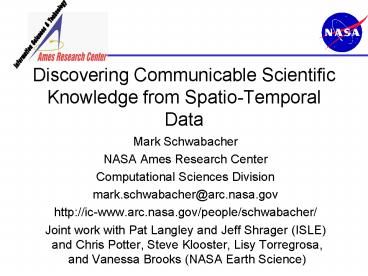Discovering Communicable Scientific Knowledge from SpatioTemporal Data - PowerPoint PPT Presentation
1 / 17
Title:
Discovering Communicable Scientific Knowledge from SpatioTemporal Data
Description:
Description of Earth science problem. Choice of representation and algorithm. Results ... Information Sciences & Technology. Testing the model across years ... – PowerPoint PPT presentation
Number of Views:45
Avg rating:3.0/5.0
Title: Discovering Communicable Scientific Knowledge from SpatioTemporal Data
1
Discovering Communicable Scientific Knowledge
from Spatio-Temporal Data
- Mark Schwabacher
- NASA Ames Research Center
- Computational Sciences Division
- mark.schwabacher_at_arc.nasa.gov
- http//ic-www.arc.nasa.gov/people/schwabacher/
- Joint work with Pat Langley and Jeff Shrager
(ISLE) and Chris Potter, Steve Klooster, Lisy
Torregrosa, and Vanessa Brooks (NASA Earth
Science)
2
Outline
- Description of Earth science problem
- Choice of representation and algorithm
- Results
- Visualizations
- Discovery of an error in the data
- Future Work
3
Earth Science Problem
- The Normalized Difference Vegetation Index (NDVI)
is a measure of vegetation across the globe
derived from satellite data - NDVI is used in various Earth-science models
- Unfortunately, NDVI is only available for the
years since 1983, when a satellite with these
sensors was launched - We would like to predict NDVI at a point on the
globe from ground-based climate variables
representing temperature, precipitation, and
moisture
4
Choice of Representation
- For scientific applications, the learned models
should be - Understandable
- Communicable
5
Representation used by scientists
- Our Earth Science collaborators had built the
following model with an if statement to select
between two linear models, one for warmer
locations and one for cooler locations - if GDDlt3000 then
- ln(NDVI) 0.715 ln(GDD) 0.377 ln(PPT)
0.448 - if GDDgt 3000 then
- NDVI 189.89 AMI 44.02 ln(PPT) 227.99
6
Choice of Algorithm
- We selected regression rules as a generalization
of the Earth scientists representation - We selected Cubist to learn themhttp//www.rulequ
est.com
7
First Results
Cubist produced better accuracy, but model was
hard to understand.
8
Varying the Cubist minimumrule cover parameter
9
2-rule Cubist model
- if PPT lt 25.457 then
- NDVI -3.225 7.07 PPT 0.0521 CDD - 84
AMI 0.4 ln(PPT) 0.0001 GDD - if PPT gt 25.457 then
- NDVI 386.3 316 AMI 0.0294 GDD - 0.99
PPT 0.2 ln(PPT)
10
Visualization 1Cubist model in one variable
11
Visualization 2 Activity of Cubist Rules
12
Visualization 2Error of Cubist model
13
Testing the model across years
- We trained Cubist using one years data
- We tested the resulting model on other years
data - If it transfers, its useful for Earth scientists
- If it sometimes doesnt transfer, that could
point to a scientific discovery
14
Discovery of an error in the data
Cross-validate 1985
Train 1984, test 1985
15
Related Work
- Regression trees Breiman et als CART (1984)
- Classification applied to Earth science Brodley
Friedl (1999) Ester, Kriegel, Xu (1996) - Visualizing classes on map Brodley Friedl
(1999) Smyth, Ghil, Ide (1999) - Detecting and correcting faulty class labels in
data John (1995) Brodley and Friedl (1999) - Detecting and correcting calibration problems in
remote-sensing systems using predefined model
Chen (1997)
16
Future Work
- Cubist/NDVI work
- Incorporate time explicitly
- Include other variables (e.g. elevation)
- Test understandability
- Other work
- Improve CASA model (next talk)
- Implement an interactive system that lets
scientists direct high-level search for improved
ecosystem models
17
Lessons Learned
- Weve identified three problems that arise in
scientific applications of ML, and proposed
initial solutions - Communicability Use the same representation as
the scientists. - Understandability When using spatial data,
spatially visualize the models errors and the
activity of its components. - Quantitative errors When using time-series data,
quantitative errors can be identified by testing
a model trained on one time period against data
from other time periods.































